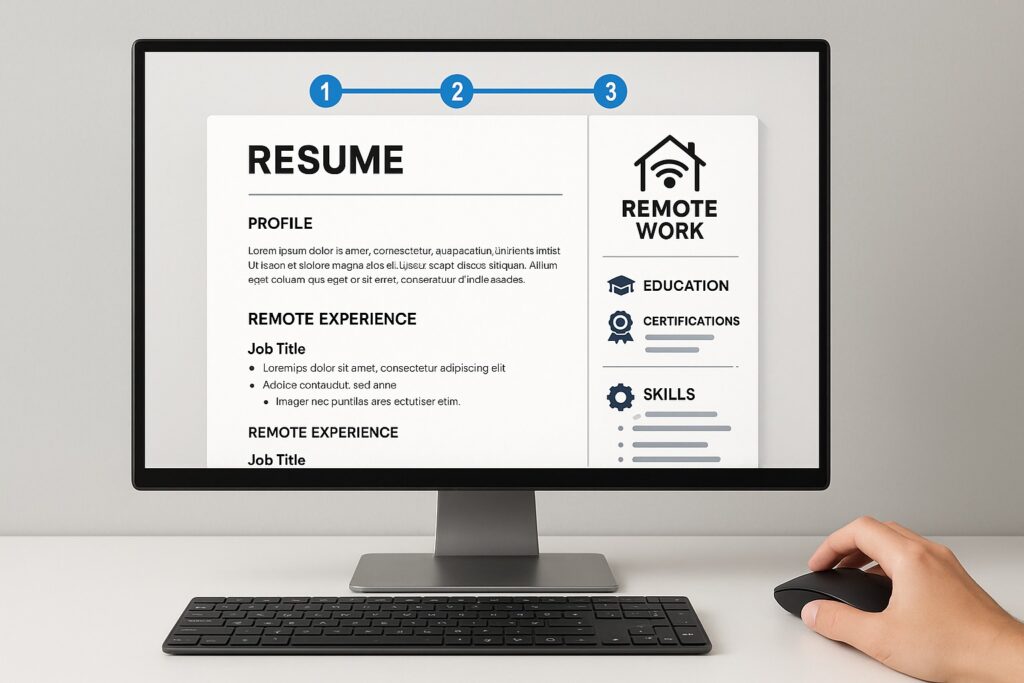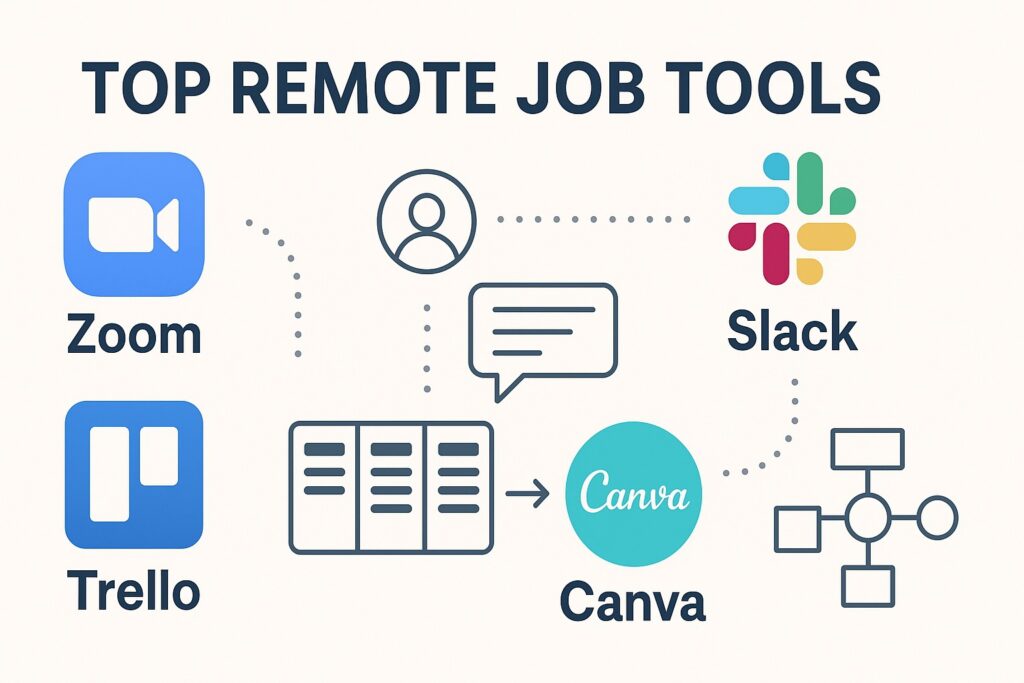Table of Contents
Introduction
Remote Jobs Without Degree are no longer a rarity in today’s modern workforce. The traditional path to a well-paying career—university degree followed by office work—is becoming less essential. Today, employers in sectors like customer support, digital marketing, writing, and virtual assistance often prioritize skills over diplomas, especially for remote roles.
If you’re wondering how to break into the remote work world without a degree, you’re in the right place. This guide will walk you through actionable steps to land remote jobs that pay well, regardless of your educational background.
You’ll learn how to:
- Identify remote roles that don’t require a degree
- Build skills quickly and affordably
- Create a standout remote resume
- Apply with confidence and strategy
Time Investment: 2-4 weeks to prepare, then apply continuously Difficulty Level: Beginner to intermediate

Prerequisites/Requirements
You don’t need a degree, but success in remote roles demands:
- Basic Computer Skills: Typing, emailing, file sharing
- Internet Connection & Device: Laptop or desktop with webcam
- Communication Skills: Especially written English
- Time Commitment: 5–10 hours/week minimum
- Learning Resources: Free or low-cost online platforms like Coursera, Udemy, or YouTube
- Mindset: Self-motivation, organization, and accountability
Optional Tools: Grammarly, Trello, Zoom, Canva (free versions work well to start)
Step‑by‑Step Process
Step 1: Identify High‑Demand Remote Job Categories
Research job categories that don’t require a degree but offer remote, high‑paying opportunities:
- Customer support
- Virtual assistance
- Freelance writing/content creation
- Social media management
- Data entry/transcription
- Sales and lead generation
Action: Visit job boards like FlexJobs, Remote OK, and Upwork. Filter roles by “no degree required.”
Pro tip: Note compensation ranges and growth potential.
Common mistake: Applying to jobs without understanding required responsibilities.
Outcome: Craft a shortlist of 3–5 potential roles to target.
Step 2: Learn Marketable Skills Fast
Once you’ve chosen a role type, focus on specific, in‑demand skills:
- Copywriting fundamentals
- Basic graphic design (Canva)
- Email marketing basics
- CRM navigation (like HubSpot)
- Proficiency in Google Workspace and Microsoft Office
Action: Enroll in HubSpot Academy for free certifications, use YouTube for tutorials, and take Coursera free trials.
Pro tip: Schedule 1‑hour learning sessions in your calendar.
Common mistake: Chasing too many courses—start with one certificate.
Outcome: Earn at least one recognized certification to display in applications.
Step 3: Build a Remote‑Friendly Resume
Now, translate skills and experience into a job‑ready resume:
- Use a clear header with your name and remote intent
- Include a results‑focused summary (“Helped small businesses increase newsletter engagement by 30%”)
- Highlight certifications and relevant projects (freelance, volunteer, personal)
- List key tools (e.g., Canva, HubSpot, Zoom, Trello)
- Format with clean visuals and plenty of white space (Canva or NovoResume templates work great)
Tool tip: Use NovoResume for ATS‑friendly layouts.
Common mistake: Long paragraphs—stick to bullet points.
Outcome: A one‑page resume that recruiters can scan in 10 seconds.

Step 4: Build an Online Presence
Recruiters often Google applicants—make sure your online footprint enhances your credibility:
- Create/update LinkedIn with certifications and a clear headline (e.g., “Remote Content Writer | HubSpot Certified”)
- Share progress and insights through short posts (e.g., “Completed Canva design certificate today!”)
- Build a free portfolio on Wix or Carrd with example work
- Join niche communities (Reddit groups, Slack channels) and contribute value
Pro tip: Use keywords from your resume in LinkedIn and portfolio.
Common mistake: Leaving your social profiles blank or outdated.
Outcome: A consistent, professional online presence across platforms
Step 5: Start Applying Strategically
With your resume and presence ready, begin job hunting:
- Use niche boards: We Work Remotely, JustRemote, Remotive
- Use filters like “entry level” or “no degree”
- Tweak each application: use role‑specific keywords in your resume and cover letter
- Set up alerts and aim to apply within 48 hours of job posting
Pro tip: Keep application tracking in a Google Sheet or Trello board.
Common mistake: Sending generic applications to many roles.
Outcome: Higher response rate and interview invitations.
Step 6: Ace the Remote Interview
Prepare thoroughly for remote interview formats:
- Common question examples:
- “How do you manage your schedule working remotely?”
- “How do you stay motivated without direct supervision?”
- Use the STAR method (Situation, Task, Action, Result) to structure answers
- Practice on Zoom or Google Meet with a friend
- Arrange your background, lighting, and audio before the call
- Tool tip: Use Google’s Interview Warmup for virtual prep
Common mistake: Failing to test tech before call time.
Troubleshooting: Have a phone nearby in case video fails.
Outcome: Confident, professional remote interview performance.
Advanced Tips & Best Practices
Build on your early progress with expert-level tactics:
- Freelancing first: Platforms like Upwork or Fiverr can help you build track record and reviews quickly
- Client testimonials: After completing projects, request short testimonials to display on LinkedIn
- Continuous learning: Dedicate a few hours monthly to new courses or tools
- Application tracking: Analyze success rates—if you’re not hearing back, revise approach or resume
- Remote work etiquette: Maintain clear communication, over‑communicate deadlines, and set status updates
- Communities: Join remote‑work forums, Slack channels, Facebook groups—quality networking pays off
Tools & Resources
Here’s a curated list of resources to accelerate your remote job search:
Learning platforms
- Coursera (free/paid courses)
- Udemy (frequent sales)
- HubSpot Academy (free certification exams)
Job boards
- We Work Remotely
- FlexJobs
- Upwork / Freelancer (for freelance roles)
- Remotive
Resume & portfolio tools
- Canva (templates, visuals)
- NovoResume (ATS‑friendly formats)
- Wix/Carrd (free portfolio websites)
Productivity & communication
- Clockify (time tracking)
- Notion / Todoist (task management)
- Zoom, Slack, Loom (remote communication)
Networking & support
- LinkedIn learning groups
- IndieHackers and Discord remote work channels

Measuring Success & Optimization
Monitor and optimize your job search using key indicators:
- Applications vs. responses: track email replies
- Interview rate: note ratio of applications to interview invites
- Portfolio traffic / LinkedIn views: signals visibility
- Interview feedback: iterate on common critique areas
Recommendation: Use spreadsheets or tools like JobTrack to visualize trends.
When something stalls—tweak your resume, change keywords, or try a different job board.
Next Steps & Advanced Techniques
After securing your first remote role:
- Step into freelance marketplaces—for side gigs or project-based income
- Automate repetitive tasks using tools like Zapier
- Learn advanced PM tools (Asana, Monday.com) for broader roles
- Consider obtaining part-time certifications or micro‑degrees to raise earning potential
- Engage with remote communities; attend virtual meetups and webinars to stay current
Conclusion
Landing a high‑pay remote job without a degree is achievable. By developing in‑demand skills, building a strong online presence, and applying deliberately, you position yourself for success—even without traditional credentials.
Follow these steps, stay consistent, and adopt a mindset of ongoing learning. Your remote career awaits. Remote jobs without degree are within reach—now it’s time to start applying!
How long does it take to land a remote job without a degree?
Typically 2–8 weeks if you build relevant skills, update your resume, and apply consistently on targeted job boards.
What skills are essential for remote jobs without a degree?
Focus on communication, time management, digital literacy (Excel, Google Docs), and basic software like Canva or HubSpot CRM.
Do I need certifications for remote jobs?
No—but free certificates from HubSpot Academy, Coursera, or LinkedIn Learning boost credibility and set you apart.
What if I have no experience at all?
Start freelancing or volunteering on Upwork or Fiverr to build a portfolio. Small projects and even pro bono work give you testimonials and samples.
Can I earn good money from remote jobs without a degree?
Yes—roles like virtual assistant, content writer, or social media manager often pay $20–$50/hour once you’ve proven yourself.
Internal Links
- Link to master resume writing with our Resume Optimization Tutorial
- Link to explore Best Freelance Platforms for Beginners
External Links
- According to FlexJobs (remote work demand data, open in new tab, rel=”noopener”)
- HubSpot Academy (free certifications, official documentation)
- Coursera (low‑cost online learning)
“Skills beat degrees. Snag your remote job by learning, showing up, and applying smart.”






[…] Check out Best High-Paying Jobs in Dubai Without a Degree […]